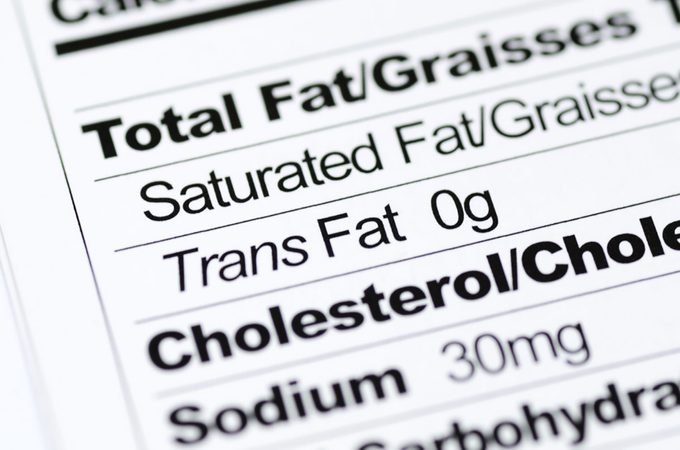8 Ways Your Nutrition Label Is Misleading You
What does "no sugar added" really mean? Is a production labeled "all natural" actually made with unaltered ingredients? Nosotros shed light on some truths that will surprise you lot.

When we want to prepare good for you meals for ourselves and our families, nosotros look for food labels like "whole grain," "low fatty," and "sugar complimentary." Merely could a seemingly healthy nutrition label be misleading you? We looked into some mutual nutrient characterization terms, plus the regulations backside them, to find out what's really going on inside the box.
ane. No Sugar Added
If you're looking to cut down on your sugar intake, you might reach for a fruit juice labeled "no carbohydrate added." The bad news is that although no sugar was added during processing, the juice however contains natural sugar—sometimes a lot of it. An 8-ounce glass of Uncomplicated Truth Organic Apple tree Juice "with no saccharide added" actually contains 30 grams of carbohydrate. That's more than a Snickers bar.
2. Natural
When yous see "natural" on a characterization, you might assume the product is salubrious. Only don't exist deceived: "Natural" actually doesn't mean much. No formal definition for the use of "natural" on nutrient labels has been issued by the U.Due south. Nutrient and Drug Assistants or U.S. Department of Agronomics. As long every bit the food doesn't contain added colors or artificial flavors, information technology can have this label. That ways there's a lot of wiggle room inside the definition. The nutrient could however comprise high-fructose corn syrup, be injected with sodium, or be produced with the utilise of pesticides. None of which sounds very natural.
iii. Made with Real Fruit
Although a product labeled "made with real fruit" must contain fruit in some course, at that place's no regulation on how much or what kind of fruit. So the food may not even contain a fruit advertised on the packaging. For example, Gerber Graduates Juice Treats feature a picture of oranges, grapes, peaches, cherries, pineapple and raspberries, yet most of them aren't even in the product. Less than 2 percent of the snack is raspberry and apple tree juice concentrate. The principal ingredients are corn syrup and sugar.
four. Fat-Free
If you're looking to lose a few pounds, y'all might think it's smart to buy foods labeled "fat-free." Merely the fat-complimentary version might actually contain more calories than its full-fat counterpart. Consistency changes when fatty'southward removed. To comprehend that up, these foods are often loaded with carbohydrate and carbohydrates. E'er compare the nutritional facts to brand the best decision.
5. Whole Grain
Whole grains have numerous wellness benefits and are high in fiber, vitamins and minerals. But be aware that the whole grain label can be misleading. Some products make a whole grain claim even though they contain refined flour as the showtime ingredient. As always, exist certain to cheque the ingredients to be sure "whole grain" is actually listed (every bit in whole grain flour, whole grain oats or whole grain rye).
Hungry for whole grains? Nosotros have some real whole grain recipes here.
6. Lightly Sweetened
Although the FDA regulates terms like "depression saccharide" and "reduced carbohydrate," a phrase like "lightly sweetened" is a way for marketers to go around these standards. "Lightly sweetened" doesn't officially hateful a matter. The implication is that the product contains a small amount of carbohydrate, merely it could really be loaded with it.
(Psst...if you want to know how to cut the carbohydrate in your own recipes, try these hacks.)
7. Naught Trans Fat
Artificial trans fats are the worst of all fats, increasing the risk of center attack, stroke, diabetes and other health issues. The FDA has finalized its decision to eliminate trans fats from nutrient, just manufacturers take until 2022 to run across the new standards. And then for now, be leery of "0 trans fat" claims. The label can say zero as long equally there are 0.5 grams max of trans fatty per serving. And that small amount can add upward if you consume more than ane serving.
viii. High Fiber
Nutrient claiming to be "high fiber" must contain at to the lowest degree five grams of cobweb per serving. The problem is, these foods are often made with candy fiber, which is not as healthy as naturally occurring fibers in foods (read: They can even cause bloating and gas). The healthier choice is to turn to fruit, vegetables and legumes for your fiber intake.
Before you lot hit the grocery store aisles, recall that yous shouldn't believe everything yous read. If you bank check out the nutritional facts and list of ingredients earlier calculation something to your cart, you'll exist the savviest shopper effectually.
robinsonprionsprould.blogspot.com
Source: https://www.tasteofhome.com/article/ways-your-nutrition-label-is-misleading-you/
0 Response to "8 Ways Your Nutrition Label Is Misleading You"
Post a Comment